Posted by: Northwest Eye in General on October 1, 2025
Overview
This article is dedicated to helping you recognize the key symptoms of dry eye syndrome. These symptoms often include:
- Persistent dryness
- Discomfort in your eyes
- Blurred vision
- Redness, among others
We understand that experiencing these issues can be concerning, and it’s crucial to identify them for timely intervention and effective management. Statistics show the prevalence of these symptoms, highlighting how environmental factors and underlying conditions can impact your eye health. Remember, you are not alone in this journey, and seeking care can lead to better management of your symptoms.
Introduction
Dry eye syndrome is a condition that affects millions of people, often leading to discomfort and frustration in daily life. We understand how challenging it can be to manage this condition. Recognizing the key symptoms is essential for effective management and treatment, as many individuals may not realize the extent of their condition. What are the signs that indicate a deeper issue, and when should you seek professional help? This article delves into the ten critical symptoms of dry eye syndrome, providing insights that can empower you to take charge of your eye health and enhance your quality of life.
Northwest Eye: Expert Care for Dry Eye Syndrome
At Northwest Eye, we understand that dealing with dry eye syndrome symptoms can be a frustrating experience. This prevalent condition affects millions, yet it is often underestimated. Our compassionate team of skilled ophthalmic surgeons is here to help, utilizing advanced technology and creative treatment options tailored to meet your unique needs.
With over 50 years of experience in eye care, we are dedicated to enhancing your vision and overall eye health. Recent advancements in dry eye treatment, including the approval of new therapies in 2025, have significantly improved management strategies, providing hope for better outcomes.
It’s common to feel overwhelmed, especially knowing that nearly 16 million Americans are affected by dry eye syndrome symptoms, with projections suggesting that up to 150 million may face these challenges, often exacerbated by factors like extended screen time and environmental conditions. Additionally, systemic conditions such as diabetes and Sjögren syndrome can increase the risk of dry eye syndrome symptoms.
Our thorough approach not only addresses your symptoms but also focuses on the root causes, leading to positive outcomes for individuals. We are here to support you every step of the way. Testimonials from those we serve reflect the effectiveness of our treatments and the compassionate care they receive, reinforcing our commitment to excellence in eye health management. Remember, we are here to help you through this process.
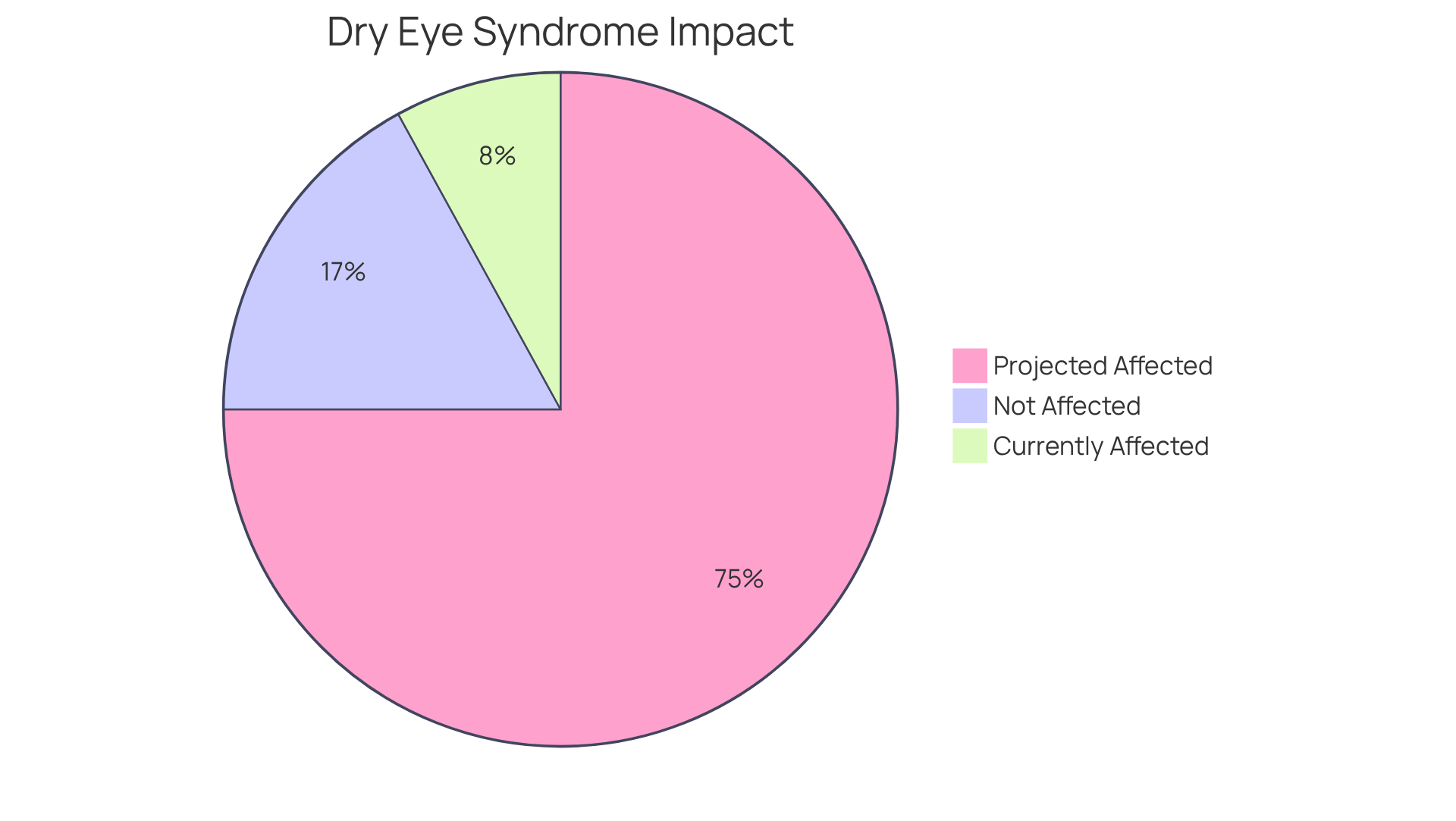
Persistent Dryness: A Key Indicator of Dry Eye Syndrome
Persistent dryness is a defining indication of dry eye syndrome symptoms, often manifesting as a range of discomfort from mild irritation to severe distress. We understand that this sensation can significantly , making tasks such as reading, working on a computer, or even driving challenging. Studies reveal that a significant proportion of individuals report facing ongoing dryness. Research demonstrates that the total occurrence of dry eye was determined to be 14.4% in the Beaver Dam Eye Study, and as many as 54% of persons attending outpatient clinics display signs of dry eye. Eye care specialists highlight that this ongoing feeling can happen even following the use of artificial tears, indicating that numerous individuals may need more sophisticated treatment approaches.
Recent advancements in treatment methods for persistent dryness include the use of prescription eye drops, which can offer more effective relief for those with serious issues. Additionally, lifestyle modifications, such as increasing humidity in living spaces and reducing airflow, have been shown to alleviate discomfort. Ongoing research continues to explore innovative therapies aimed at addressing the underlying causes of dry eye syndrome, ensuring that patients receive tailored solutions that enhance their quality of life.
As Suchi Vinod Shah notes, “Dry eye is a very common as well as under-diagnosed ocular disorder. It is not only problematic regarding its indicators but also places a significant financial strain.”
As awareness of dry eye syndrome symptoms grows, we recognize that understanding persistent dryness as a key indicator becomes increasingly vital for effective management and treatment. We are here to help you through this process.
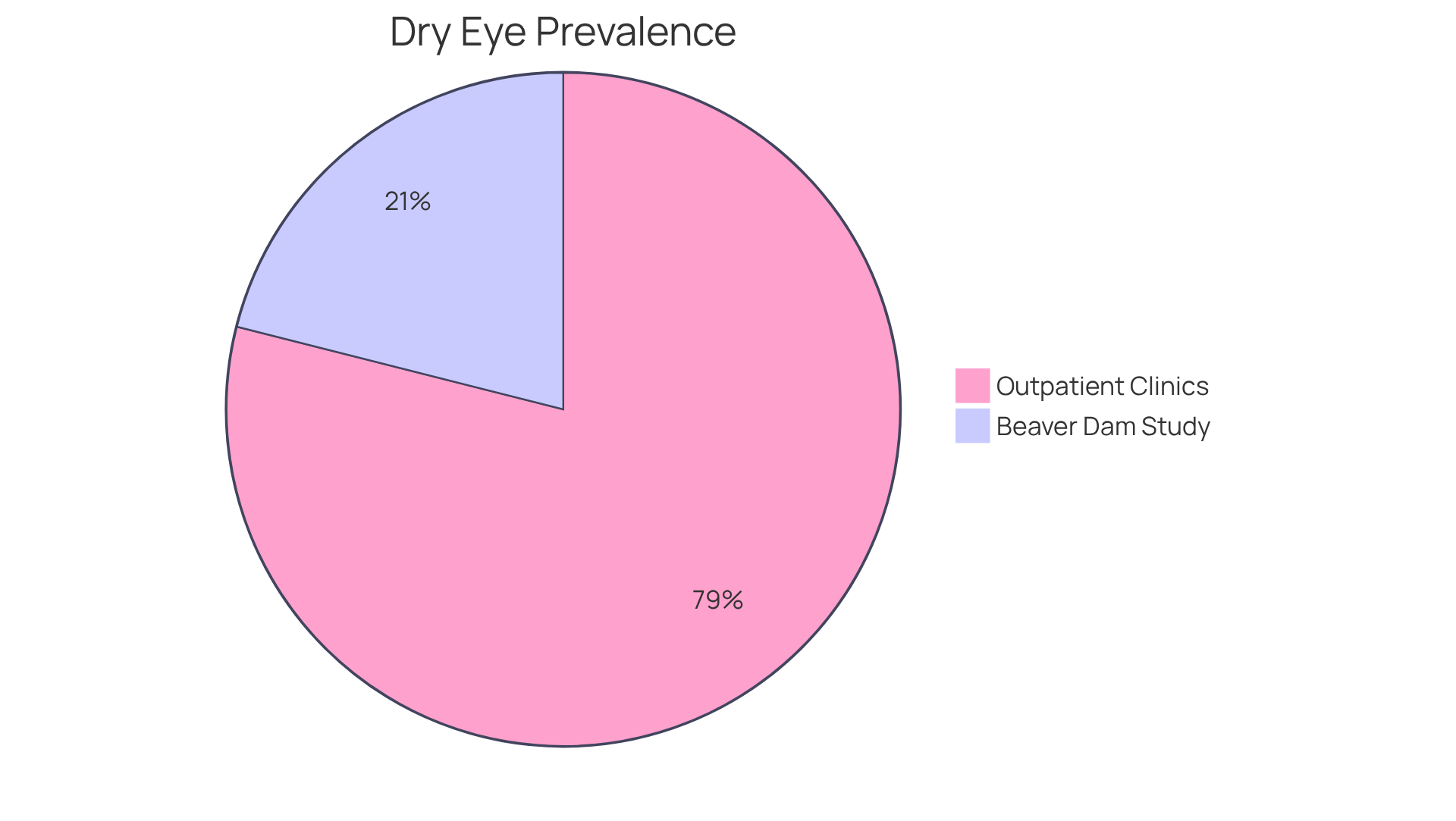
Eye Discomfort: Recognizing the Signs of Dry Eye Syndrome
Patients experiencing dry eye syndrome symptoms often describe discomfort that feels like stinging, burning, or a heaviness in the eyes. We understand that these signs can be made worse by such as low humidity, wind, smoke, and long hours spent in front of screens. It’s common to feel overwhelmed, especially for those who spend over ten hours a day on screens, as they report a noticeable increase in dry eye syndrome symptoms.
Recognizing the dry eye syndrome symptoms is crucial for seeking timely intervention, which can lead to improved eye health and comfort. The cornea plays a vital role in this process, focusing light onto the lens, filtering harmful UV light, and protecting the eye from germs and bacteria. Addressing environmental triggers is essential. Simple actions like using humidifiers in dry conditions or taking regular breaks from screens can significantly alleviate dry eye discomfort and support overall corneal health.
We are here to help you through this process, and taking these steps can make a meaningful difference in your daily comfort.
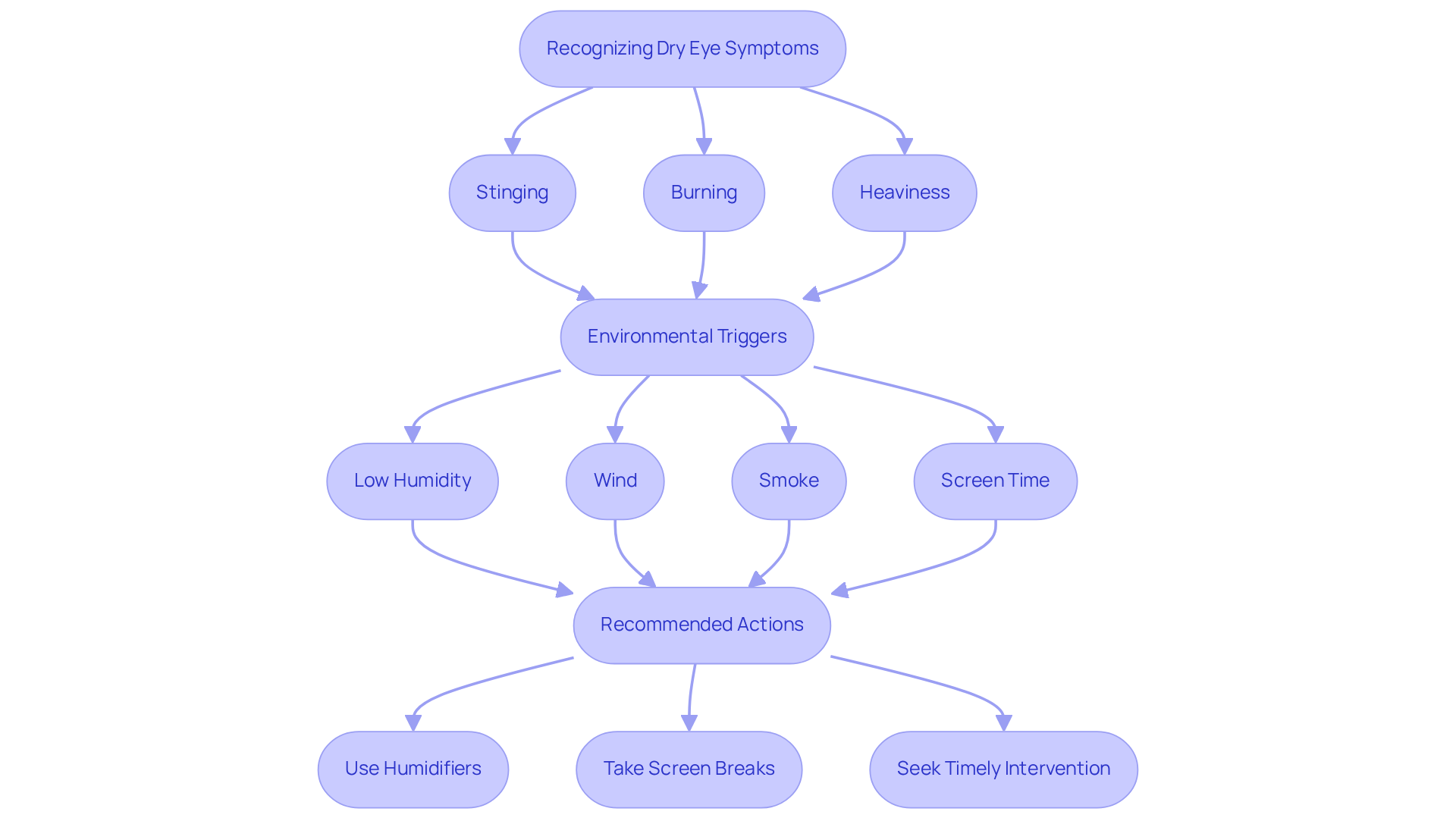
Blurred Vision: A Common Symptom of Dry Eye Syndrome
Blurred vision is a common dry eye syndrome symptom, often caused by an unstable tear film that disrupts visual clarity. We understand that this can be concerning. Research shows that 58% of individuals with dry eye syndrome symptoms report experiencing moderate-to-very-severe blurred vision, highlighting how significantly this condition can affect daily life. It’s common to feel frustrated, especially during tasks that require prolonged focus, like reading or using digital devices.
Vision specialists emphasize the importance of a for maintaining clear sight. As Adam Felman notes, “Along with blurry vision, dry eye syndrome symptoms encompass a range of other effects, including redness, the sensation of stinging, burning, scratching, or grittiness.” Additionally, blurred vision may indicate other underlying issues, such as cataracts or uncorrected refractive errors, which can complicate visual clarity.
Addressing the underlying causes of dry eye is vital. Enhancing tear production through artificial tears and making lifestyle changes, such as reducing screen time, can significantly restore clearer vision and improve overall visual comfort. We want to reassure you that there are effective management strategies available. Furthermore, the negative impact of dry eye disease on health-related quality of life (HR-QoL) underscores the importance of seeking care. Remember, we are here to help you through this process.
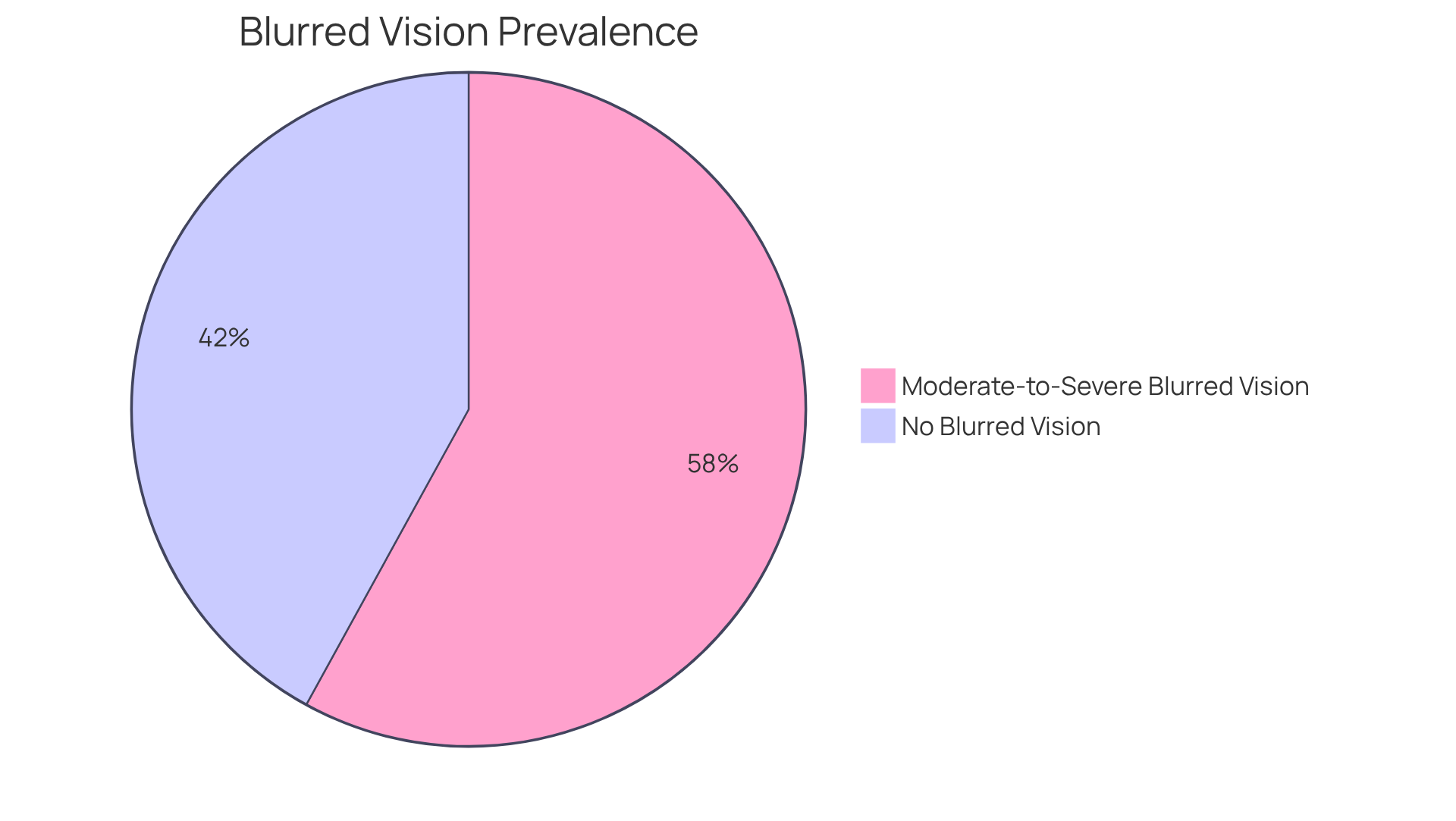
Gritty Sensation: Identifying Dry Eye Syndrome Symptoms
Patients with dry eye syndrome symptoms often describe a gritty or sandy sensation in their eyes, akin to having a foreign object lodged within. We understand that this discomfort can lead to habitual eye rubbing, which may worsen the condition and contribute to further irritation. Identifying this indication is crucial, as it allows you to express your experiences more effectively to your eye care specialists.
Statistics indicate that nearly half of all U.S. adults may experience dry eye syndrome symptoms, with many reporting the gritty feeling as a primary concern. It’s common to feel frustrated by the symptoms of dry eye syndrome. Effective communication strategies, such as clearly describing the sensation and its impact on your daily activities, can facilitate better diagnosis and management.
Eye care professionals emphasize the importance of addressing dry eye syndrome symptoms, as these can significantly affect overall eye comfort and quality of life. Understanding the nuances of this can empower you to seek timely interventions and improve your eye health. Remember, we are here to help you through this process.
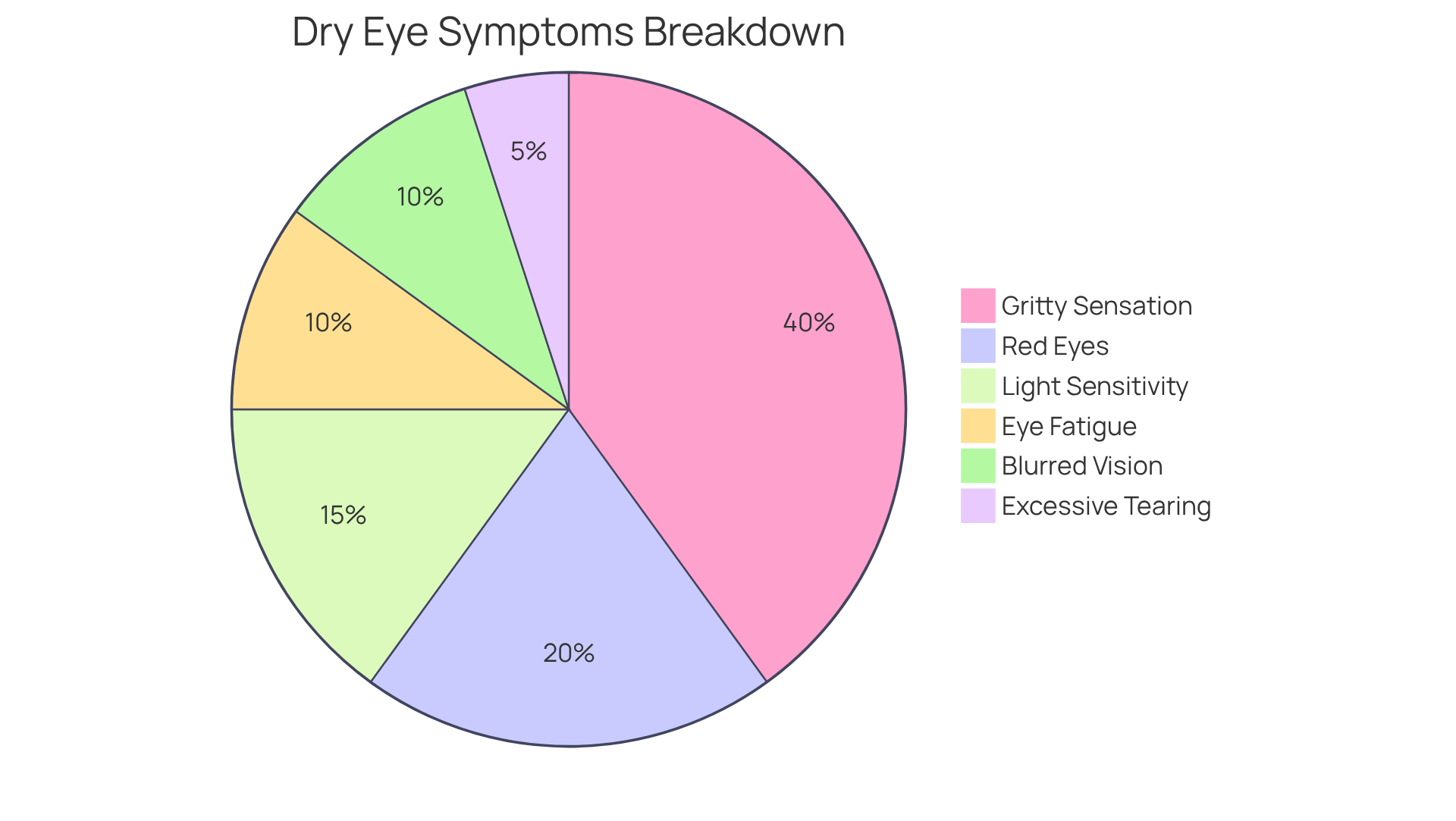
Redness in the Eyes: A Visible Sign of Dry Eye Syndrome
Redness in the eyes is a common and visible sign of dry eye syndrome symptoms, often resulting from inflammation due to insufficient lubrication. We understand that this inflammation can be worsened by environmental irritants or , leading to noticeable redness. It’s important to recognize that persistent redness may indicate a need for more intensive treatment strategies. Research shows that nearly 47% of Americans experience frequent or occasional dry eye syndrome symptoms, with redness being a prevalent concern among these individuals.
Effective management options are available, including:
- Prescription eye drops
- Eyelid cleansers
These can significantly relieve discomfort and enhance ocular health. Recognizing the implications of eye redness is crucial, as it often reflects the severity of dry eye syndrome symptoms and the underlying inflammatory processes at play. We are here to help you through this process and ensure your comfort and well-being.
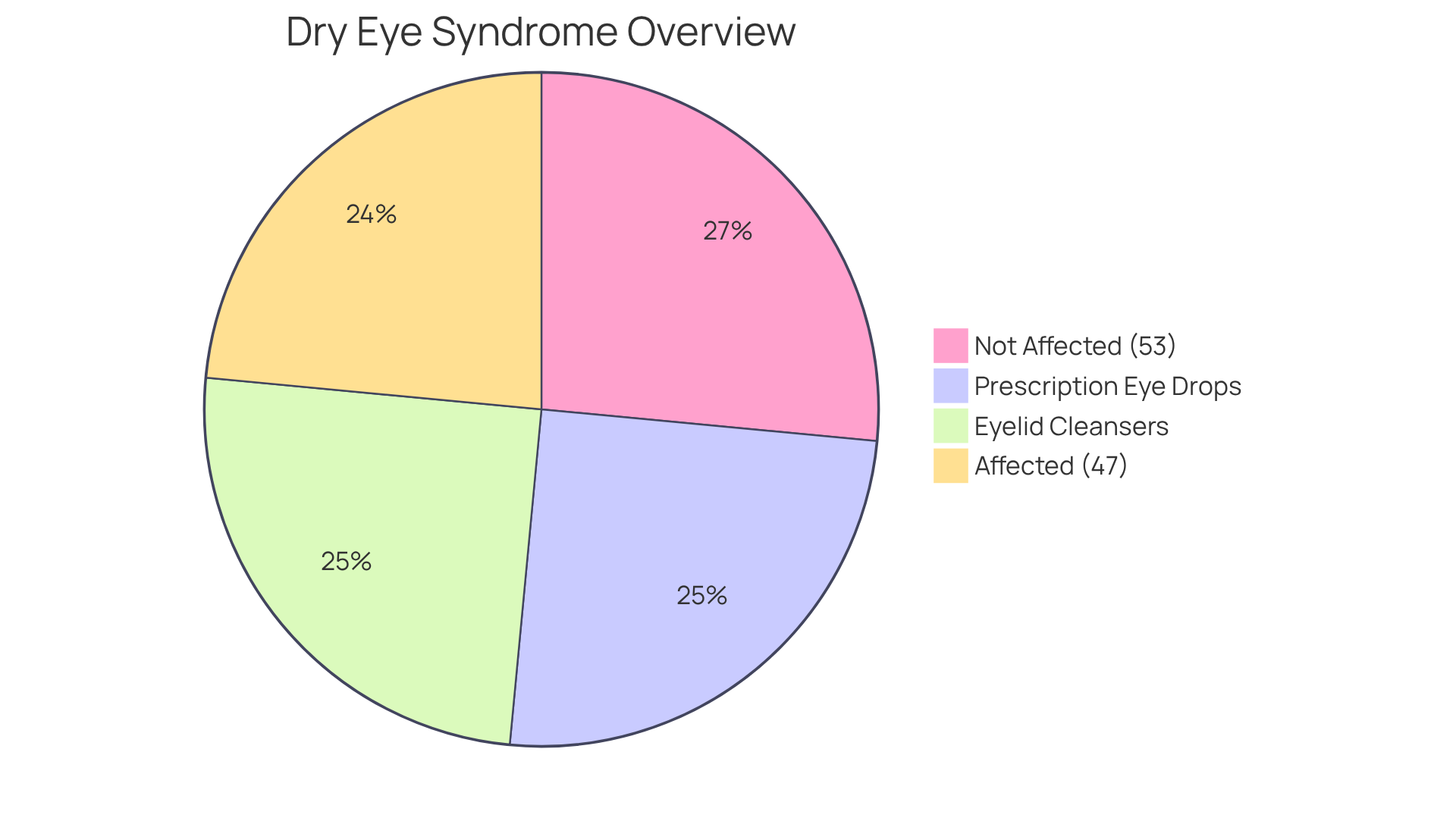
Light Sensitivity: Understanding Its Role in Dry Eye Syndrome
Light sensitivity is among the common dry eye syndrome symptoms experienced by individuals, and it can significantly impact daily life. We understand that this heightened sensitivity can lead to discomfort in bright environments and during prolonged screen exposure, making everyday activities a challenge. Many individuals report that even moderate lighting can provoke discomfort, affecting their ability to work or engage in social situations.
To effectively manage light sensitivity, individuals often find relief through various strategies.
- Wearing sunglasses outdoors can help shield the eyes from harsh sunlight.
- Additionally, specialized eyewear designed to filter out harmful wavelengths, such as TheraSpecs, can be beneficial indoors.
- Adjusting indoor lighting to reduce glare and using anti-reflective screens can also create a more comfortable environment.
At Northwest Eye, we emphasize the importance of personalized management plans for those suffering from light sensitivity. Our experts recommend regular consultations with eye care specialists to tailor strategies that address individual needs. For example, flexible work arrangements, including adjustable lighting options and screen time management, can greatly improve comfort levels. We also encourage you to view our video on the Light Adjustable Lens, which offers insights into how this innovative solution can enhance visual comfort and lessen light sensitivity for those with cataracts.
The impact of light sensitivity goes beyond physical discomfort; it can also affect mental well-being. It’s common to feel anxious or stressed in bright settings, which can lead to a decrease in overall quality of life. Understanding and addressing these feelings is essential for enhancing daily functioning and emotional well-being.
In summary, dry eye syndrome symptoms, particularly light sensitivity, are a significant concern for those affected. With effective management approaches, innovative solutions like the Light Adjustable Lens, and at Northwest Eye, you can navigate these challenges and improve your quality of life.
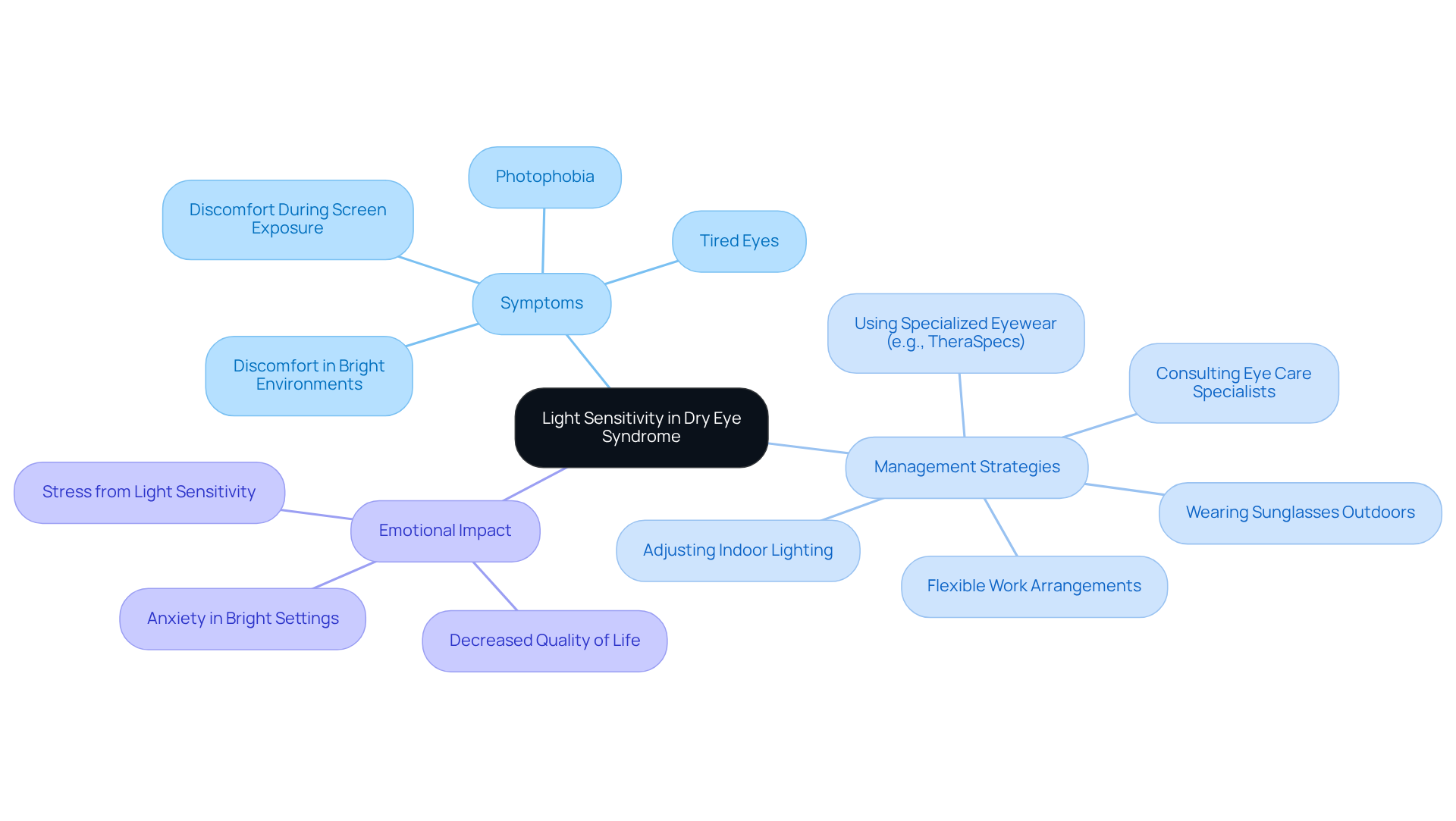
Excessive Tearing: An Unexpected Symptom of Dry Eye Syndrome
Excessive tearing can be a surprising sign for those experiencing dry eye syndrome. We understand that this paradox arises when the eyes become so dry that they trigger an as a compensatory response. Unfortunately, these tears often lack the necessary components for effective lubrication, leading to further discomfort. For example, studies indicate that:
- 67% of individuals with diabetes experience dry eye, which can exacerbate this paradoxical tearing.
- A staggering 95% of individuals with blocked meibomian glands also exhibit dry eye, underscoring the importance of recognizing this symptom for effective management.
- It’s also worth noting that 60% of smokers experience dry eye, suggesting another risk factor that could affect those with cataracts.
Recognizing the nuances of excessive tearing is crucial, as it can lead to misdiagnosis and inappropriate treatment if not properly addressed. At Northwest Eye, our specialists utilize advanced evaluation methods, including LipiView® and Tear Osmolarity tests, to assess tear quality and volume, ensuring a comprehensive understanding of each individual’s condition. As Suchi Vinod Shah observes, “Chronic dry eye issues can result in complications such as reduced quality of life and a decline in mental health.” By educating patients about this phenomenon and offering innovative treatments like LipiFlow® and BlephEx®, we can develop more effective management strategies that alleviate discomfort and improve overall eye health. We are here to help you through this process.
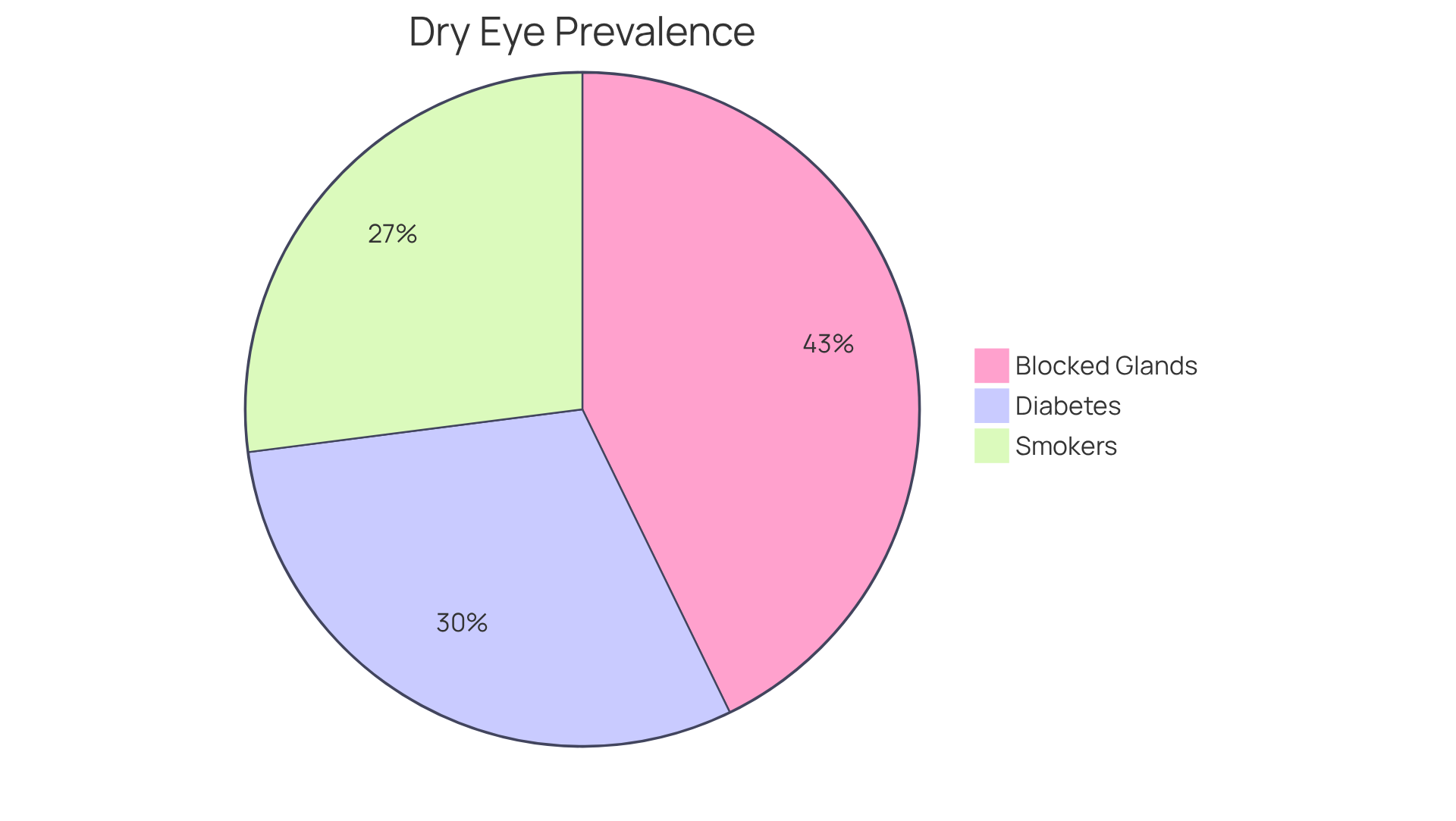
Difficulty Wearing Contact Lenses: A Symptom of Dry Eye Syndrome
Dry eye syndrome can significantly impact the comfort of those who wear contact lenses, leading to a range of distressing issues. Many individuals find themselves grappling with dry eye syndrome symptoms, including:
- Dryness
- Discomfort
- Blurred vision
This makes lens wear feel unbearable. It’s common to feel this way; studies show that approximately 50% of contact lens wearers experience some form of dryness, with over 25% discontinuing use due to discomfort. If you are facing these challenges, we understand how frustrating it can be, and it’s essential to consult with an eye care expert. They can help you explore alternative options or treatments tailored to your specific needs.
Eye care professionals emphasize the importance of recognizing dry eye syndrome symptoms for accurate diagnosis. Understanding the severity of your condition can guide effective management strategies. We want you to know that addressing these challenges early on can lead to with your vision correction options. Remember, you are not alone in this journey, and we are here to help you through the process.
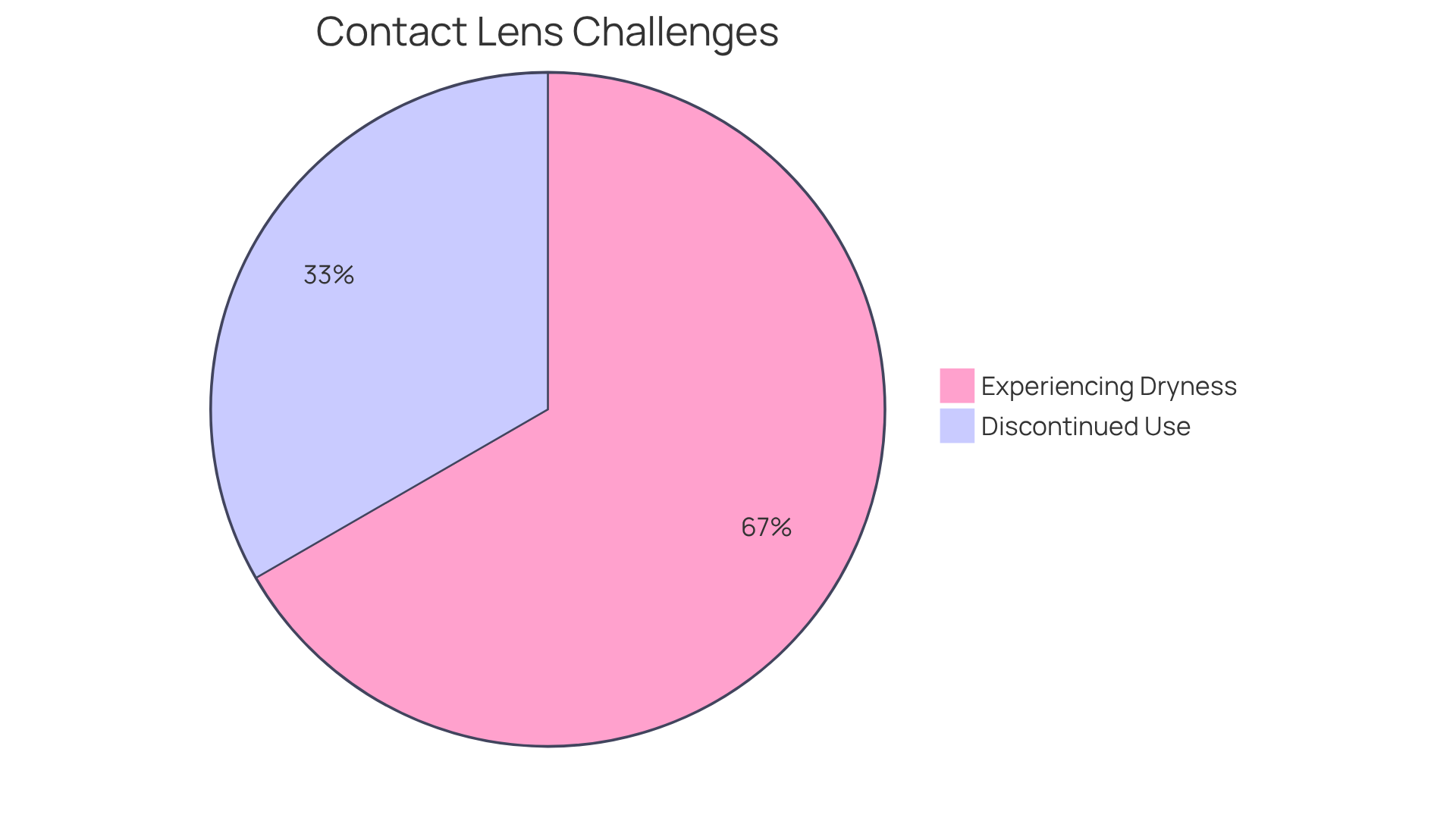
When to Seek Help: Recognizing Serious Symptoms of Dry Eye Syndrome
Identifying when dry eye symptoms require professional assessment is crucial for maintaining your eye health. We understand that experiencing severe discomfort, , and significant changes in vision can be alarming. These key indicators warrant immediate attention from an eye care provider. Research shows that nearly 19% of diagnosed patients with dry eye syndrome symptoms report pain, while 44% experience blurred vision. This highlights the prevalence of serious issues among those affected.
Early intervention is essential. It can prevent complications and significantly enhance your quality of life. Ophthalmologists emphasize that timely assessment and treatment can lead to better outcomes. It’s vital not to ignore these warning signs. If you find yourself experiencing any of these severe symptoms, please do not hesitate to seek professional help. We are here to support you through this process.
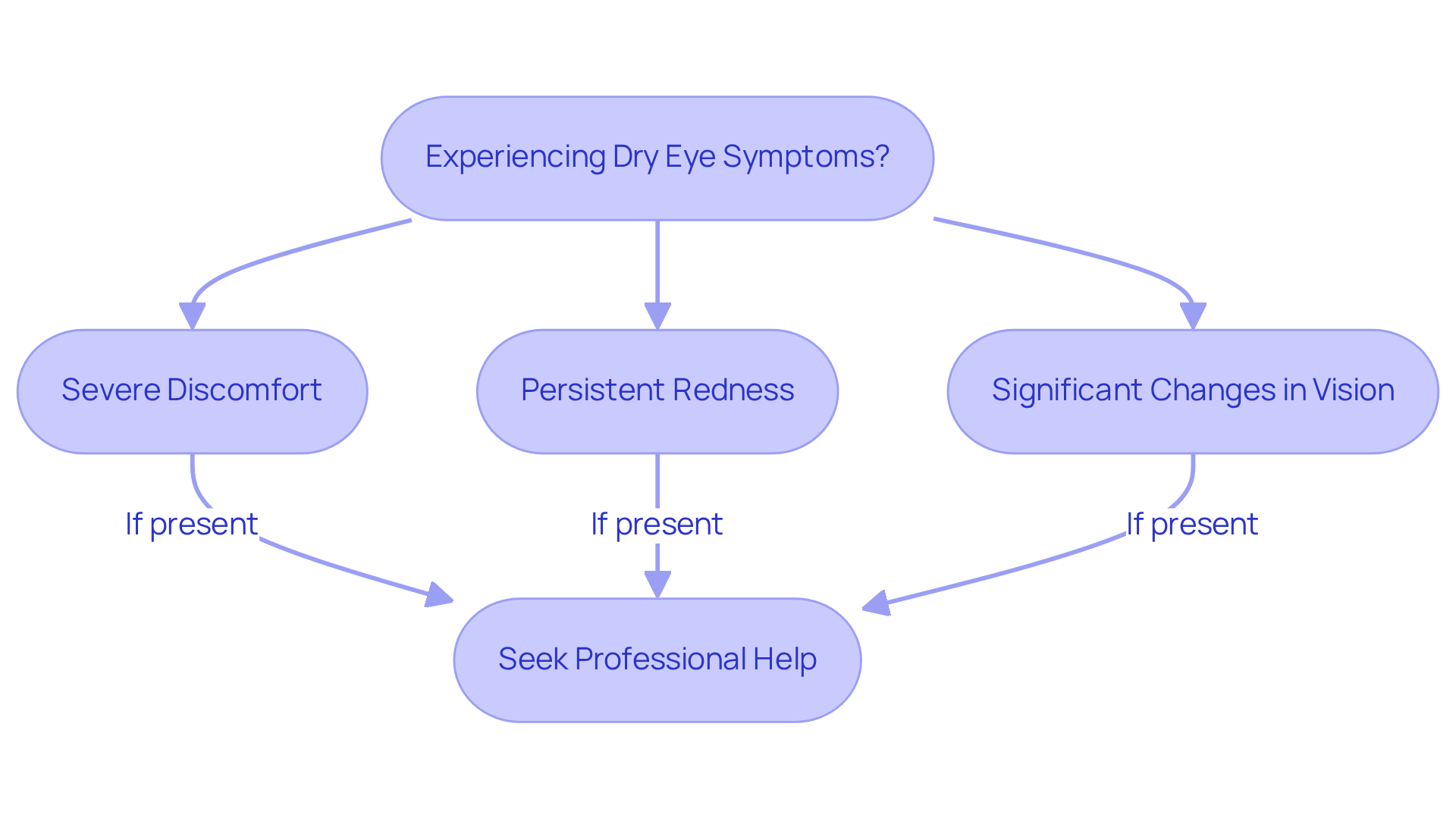
Conclusion
Understanding dry eye syndrome is crucial for anyone affected by its myriad symptoms, which can significantly disrupt daily life. We understand that living with persistent dryness, eye discomfort, blurred vision, gritty sensations, redness, light sensitivity, excessive tearing, and challenges with contact lens wear can be overwhelming. Recognizing these symptoms is the first step toward seeking appropriate care and improving overall eye health.
The insights provided underscore the importance of timely intervention and personalized treatment plans. With advancements in therapies and a deeper understanding of the condition, individuals can find relief and enhance their quality of life. From lifestyle modifications to innovative treatment options available at specialized centers like Northwest Eye, effective management strategies are within reach.
It’s common to feel uncertain when experiencing these symptoms, but it is essential for those affected to consult with eye care professionals promptly. By addressing dry eye syndrome early and effectively, individuals can regain comfort and clarity in their vision. Remember, support is available, and taking proactive steps can lead to a more comfortable and fulfilling life.
Frequently Asked Questions
What is dry eye syndrome and how prevalent is it?
Dry eye syndrome is a common condition characterized by persistent dryness and discomfort in the eyes. It affects nearly 16 million Americans, with projections suggesting that up to 150 million may experience symptoms, often exacerbated by extended screen time and environmental factors.
What are the common symptoms of dry eye syndrome?
Common symptoms include persistent dryness, stinging, burning, and a feeling of heaviness in the eyes. These symptoms can be worsened by environmental conditions like low humidity, wind, and prolonged screen exposure.
How does Northwest Eye approach the treatment of dry eye syndrome?
Northwest Eye utilizes advanced technology and creative treatment options tailored to individual needs. Their approach focuses on addressing both the symptoms and the root causes of dry eye syndrome to improve overall eye health.
What recent advancements have been made in the treatment of dry eye syndrome?
Recent advancements include the approval of new therapies in 2025, the use of prescription eye drops for more effective relief, and ongoing research into innovative therapies aimed at addressing underlying causes.
What lifestyle modifications can help alleviate dry eye symptoms?
Lifestyle modifications such as increasing humidity in living spaces, reducing airflow, and taking regular breaks from screens can help alleviate discomfort associated with dry eye syndrome.
Why is it important to recognize the signs of dry eye syndrome?
Recognizing the signs of dry eye syndrome is crucial for seeking timely intervention, which can lead to improved eye health and comfort. Early identification can help patients receive appropriate treatments.
What role does the cornea play in eye health related to dry eye syndrome?
The cornea focuses light onto the lens, filters harmful UV light, and protects the eye from germs and bacteria. Maintaining corneal health is essential for managing dry eye symptoms effectively.
How does Northwest Eye support patients with dry eye syndrome?
Northwest Eye offers compassionate care and support throughout the treatment process, with testimonials reflecting the effectiveness of their treatments and commitment to excellence in eye health management.






